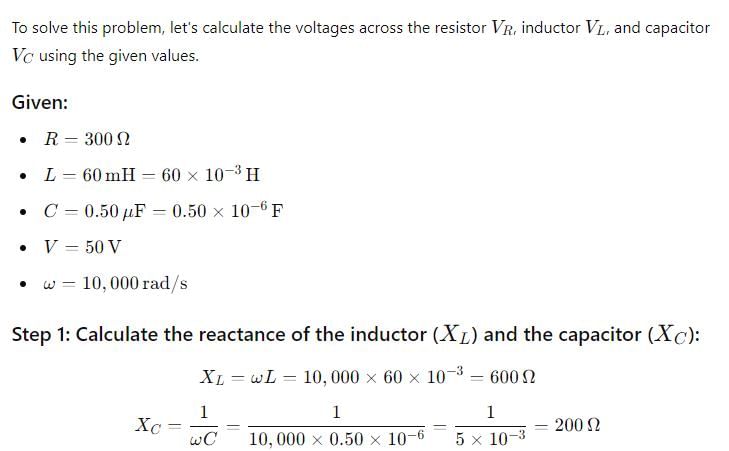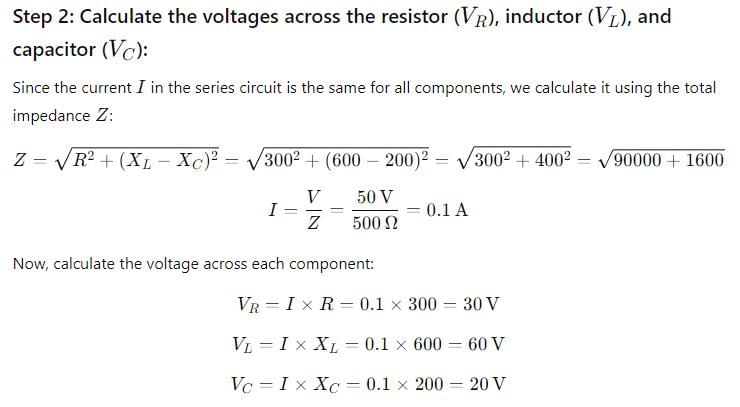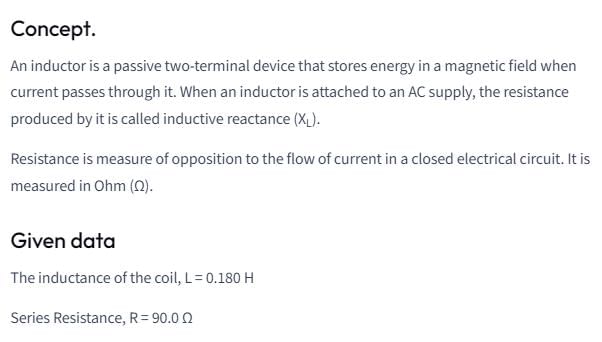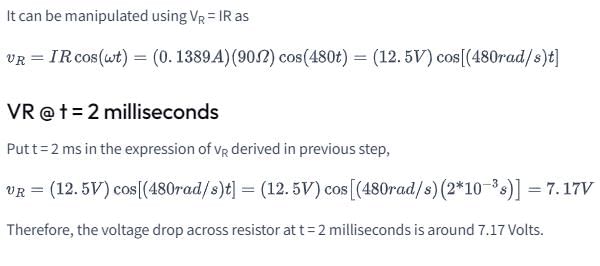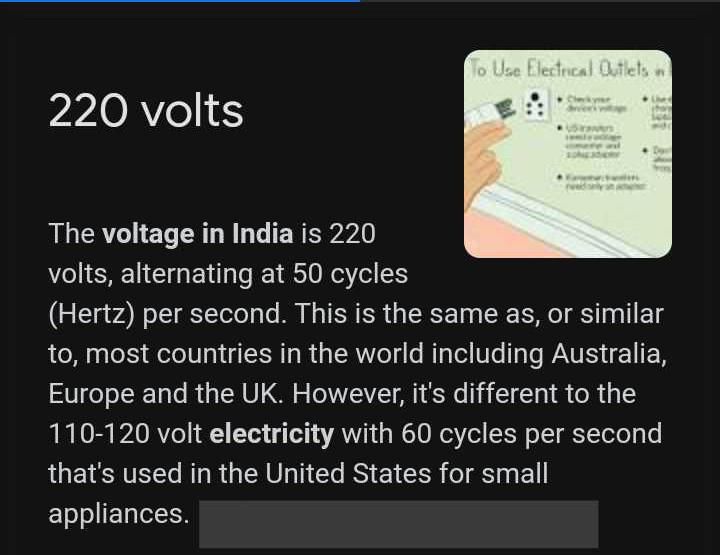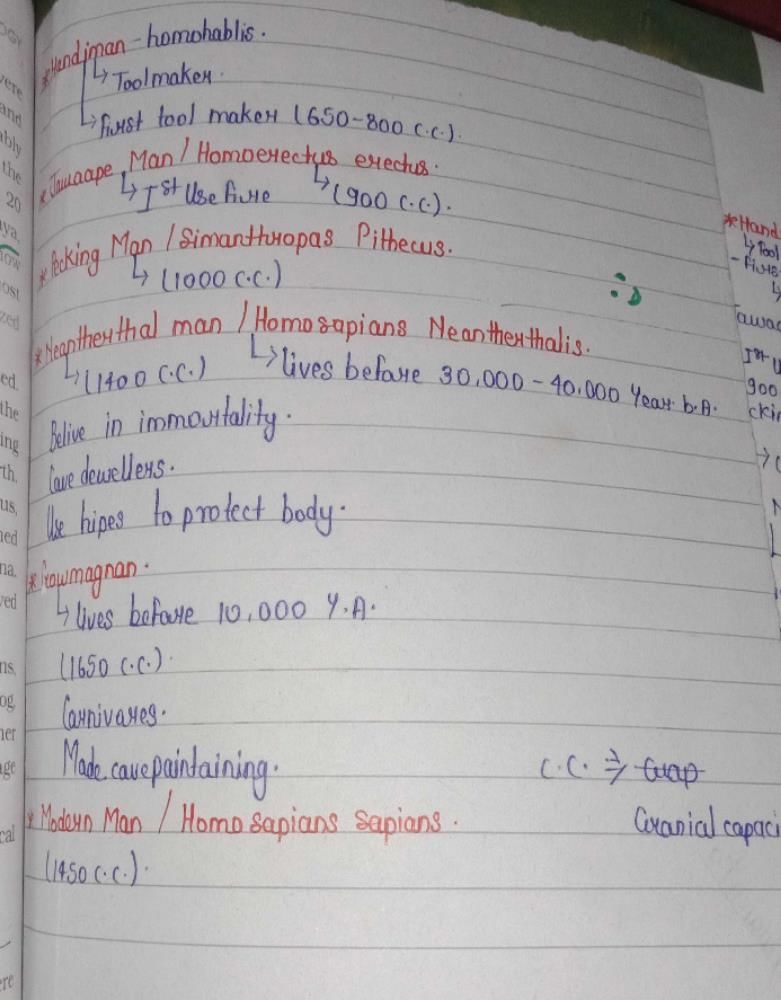All Exams >
NEET >
Weekly Tests for NEET Preparation >
All Questions
All questions of October Week 3 for NEET Exam
In an inductance the current- a)is in phase
- b)leads the voltage
- c)lags the voltage
- d)builds very fast
Correct answer is option 'C'. Can you explain this answer?
In an inductance the current
a)
is in phase
b)
leads the voltage
c)
lags the voltage
d)
builds very fast
|
|
Krishna Iyer answered |
In an inductor, current lags behind the input voltage by a phase difference of π/2.
Current and voltage are in the same phase in the resistor whereas current leads the voltage by π/2 in a capacitor.
So, the circuit must contain an inductor only.
Current and voltage are in the same phase in the resistor whereas current leads the voltage by π/2 in a capacitor.
So, the circuit must contain an inductor only.
Homo sapiens arose in Africa and moved across continents and developed into distinct races during?- a)Ice age between 75000-10,000 years ago
- b)Ice age between 5000-6000 years ago
- c)Stone age between 10,000 years ago
- d)Stone age between 2000-4000 years ago
Correct answer is option 'A'. Can you explain this answer?
Homo sapiens arose in Africa and moved across continents and developed into distinct races during?
a)
Ice age between 75000-10,000 years ago
b)
Ice age between 5000-6000 years ago
c)
Stone age between 10,000 years ago
d)
Stone age between 2000-4000 years ago
|
|
Kushagra Budhgaya answered |
Answer A is correct. why don't you go through the ncert once.
Which of the following bird will be called most successfully evolved?- a)Lays 5 eggs, 5 hatch and 5 reproduce
- b)Lays 9 eggs, 9 hatch and 3 reproduce
- c)Lays 2 eggs, 2 hatch and 2 reproduce
- d)Lays 10 eggs, 5 hatch and 4 reproduce
Correct answer is option 'A'. Can you explain this answer?
Which of the following bird will be called most successfully evolved?
a)
Lays 5 eggs, 5 hatch and 5 reproduce
b)
Lays 9 eggs, 9 hatch and 3 reproduce
c)
Lays 2 eggs, 2 hatch and 2 reproduce
d)
Lays 10 eggs, 5 hatch and 4 reproduce

|
Rupesh Ganguli answered |
Correct answer is a because according to Darwin the who leaves more Number of reproducing individuals are more successful
A hair dryer meant for 110V 60Hz is to be used in India . If 220 V is the supply voltage in India , the turns ratio for a transformer would be- a)step-down 2.5:1
- b)step-up 1:2
- c)step-down 3:1
- d)step-down 2:1
Correct answer is option 'D'. Can you explain this answer?
A hair dryer meant for 110V 60Hz is to be used in India . If 220 V is the supply voltage in India , the turns ratio for a transformer would be
a)
step-down 2.5:1
b)
step-up 1:2
c)
step-down 3:1
d)
step-down 2:1
|
|
Suresh Iyer answered |
Here Vp=220V Vs=110V
As we know the relation between V and n,
As,
Ve/Vs=np/ns ->220/110
Np/ns=2/1=2:1
Therefore, no. of turns in primary is greater than no. of turns in secondary,
Hence, it is a step-down transformer.
As we know the relation between V and n,
As,
Ve/Vs=np/ns ->220/110
Np/ns=2/1=2:1
Therefore, no. of turns in primary is greater than no. of turns in secondary,
Hence, it is a step-down transformer.
The current amplitude in a pure inductor in a radio receiver is to be 250 μA when the voltage amplitude is 3.60 V at a frequency of 1.60 MHz (at the upper end of the AM broadcast band). If the voltage amplitude is kept constant, what will be the current amplitude through this inductor at 16.0 MHz?- a)20.0 μA
- b)33.0 μA
- c).35.0 μA
- d)25.0 μA
Correct answer is option 'D'. Can you explain this answer?
The current amplitude in a pure inductor in a radio receiver is to be 250 μA when the voltage amplitude is 3.60 V at a frequency of 1.60 MHz (at the upper end of the AM broadcast band). If the voltage amplitude is kept constant, what will be the current amplitude through this inductor at 16.0 MHz?
a)
20.0 μA
b)
33.0 μA
c)
.35.0 μA
d)
25.0 μA
|
|
Preeti Khanna answered |
I0=250μA, v0=3.6v . v=1.6x106 Hz
Here,
(Reactance of inductance) XL=ωL
XL=2πv X L
v0/I0=2πv x L
3.6/2.5x10-4=2πx1.6x10-6 x L
0.14x104-6=L
L=0.14x10-2H
Now for v=16.0x106Hz
XL=2πv X L
=2πx16x106x14x10-4
XL=1407x102Ω
Now,
v0=I0 x XL
3.6/1407x102=I0 [∵v0=kept constant.]
I0=0.00256x10-2
I0=25.6μA
Here,
(Reactance of inductance) XL=ωL
XL=2πv X L
v0/I0=2πv x L
3.6/2.5x10-4=2πx1.6x10-6 x L
0.14x104-6=L
L=0.14x10-2H
Now for v=16.0x106Hz
XL=2πv X L
=2πx16x106x14x10-4
XL=1407x102Ω
Now,
v0=I0 x XL
3.6/1407x102=I0 [∵v0=kept constant.]
I0=0.00256x10-2
I0=25.6μA
By studying analogous structures we look for ______.- a)Similarities in appearance but differences in functions
- b)Similarities in appearance and function but different in structure
- c)Similarities in organ structure
- d)Similarities in cell make up
Correct answer is option 'B'. Can you explain this answer?
By studying analogous structures we look for ______.
a)
Similarities in appearance but differences in functions
b)
Similarities in appearance and function but different in structure
c)
Similarities in organ structure
d)
Similarities in cell make up
|
|
Lavanya Menon answered |
Analogous organs are those organs which have the same function but are quite different in their fundamental structure and embryonic origin. For example, the wing of an insect and the wing of a bird are analogous organs. Both these organs are used for flying in the air but they re very different in structure. An insect wing is an extension of the integument whereas a bird wing is formed of limb bones covered with flesh, skin, and feathers. Each has evolved from a separate ancestral population as a means of a more efficient mode of locomotion. Similarity developed in distantly related groups as an adaptation for the same function is called analogy or convergent evolution.
Thus, the correct answer is option B.
A sinusoidal voltage of peak value 283 V and frequency 50 Hz is applied to a series LCR circuit in which R = 3 Ω, L = 25.48 mH, and C = 796 μF. Power dissipated in the circuit; and the power factor are- a)4000 W, 0.4
- b)4800 W, 0.6
- c)4400 W, 0.6
- d)3800 W, 0.6
Correct answer is option 'B'. Can you explain this answer?
A sinusoidal voltage of peak value 283 V and frequency 50 Hz is applied to a series LCR circuit in which R = 3 Ω, L = 25.48 mH, and C = 796 μF. Power dissipated in the circuit; and the power factor are
a)
4000 W, 0.4
b)
4800 W, 0.6
c)
4400 W, 0.6
d)
3800 W, 0.6
|
|
Nandini Iyer answered |
Angular frequency of the ac signal w=2πν
∴ w=2π(50)=100π
Capacitive reactance Xc=1/wC
∴ Xc=1/(100π×786×10−6)=4Ω
Inductive reactance XL=wL
∴ XL=100π×(25.48×10−3)=8Ω
Impedance of the circuit Z=√[R2+(XL−Xc)2]
∴ Z=√[32+(8−4)2]=5Ω
Phase difference ϕ=tan−1[(XL−Xc)R]
Or ϕ=tan−1((8−4)/3)=tan−1(4/3)
⟹ ϕ=53.13o
Power factor cosϕ=cos53.13o=0.6
Power dissipated in the circuit
P=Iv2R
Now, Iv=I0/√2=E0/√2Z=283/(1.414×5)=40A
∴P=Iv2R=(40)2×3=4800 watt
∴ w=2π(50)=100π
Capacitive reactance Xc=1/wC
∴ Xc=1/(100π×786×10−6)=4Ω
Inductive reactance XL=wL
∴ XL=100π×(25.48×10−3)=8Ω
Impedance of the circuit Z=√[R2+(XL−Xc)2]
∴ Z=√[32+(8−4)2]=5Ω
Phase difference ϕ=tan−1[(XL−Xc)R]
Or ϕ=tan−1((8−4)/3)=tan−1(4/3)
⟹ ϕ=53.13o
Power factor cosϕ=cos53.13o=0.6
Power dissipated in the circuit
P=Iv2R
Now, Iv=I0/√2=E0/√2Z=283/(1.414×5)=40A
∴P=Iv2R=(40)2×3=4800 watt
In an L-R-C series circuit, the rms voltage across the resistor is 30.0 V, across the capacitor it is 90.0 V, and across the inductor it is 50.0 V. Rms voltage of the source is- a)60.0 V
- b)50.0 V
- c)65.0 V
- d)5.0 V
Correct answer is option 'A'. Can you explain this answer?
In an L-R-C series circuit, the rms voltage across the resistor is 30.0 V, across the capacitor it is 90.0 V, and across the inductor it is 50.0 V. Rms voltage of the source is
a)
60.0 V
b)
50.0 V
c)
65.0 V
d)
5.0 V
|
|
Rajat Kapoor answered |
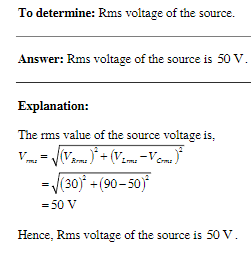
This Question Answer is
A light bulb is rated at 50W for a 220 V supply. The resistance of the bulb, the peak voltage of the source and the rms current through the bulb are- a)768 ΩΩ, 391 V, 0.297A
- b)968 ΩΩ, 311 V, 0.227A
- c)468 ΩΩ, 411 V, 0.267A
- d)968 ΩΩ, 350 V, 0.327A
Correct answer is option 'B'. Can you explain this answer?
A light bulb is rated at 50W for a 220 V supply. The resistance of the bulb, the peak voltage of the source and the rms current through the bulb are
a)
768 ΩΩ, 391 V, 0.297A
b)
968 ΩΩ, 311 V, 0.227A
c)
468 ΩΩ, 411 V, 0.267A
d)
968 ΩΩ, 350 V, 0.327A
|
|
Harsh Desai answered |
The power rating of a light bulb is given as 50W, and it is connected to a 220V supply. We need to determine the resistance of the bulb, the peak voltage of the source, and the rms current through the bulb.
To find the resistance of the bulb, we can use the formula:
Resistance (R) = (Voltage (V))^2 / Power (P)
Substituting the given values:
R = (220V)^2 / 50W
R = 48400V^2 / 50W
R = 968Ω
Therefore, the resistance of the bulb is 968Ω.
To find the peak voltage of the source, we know that the peak voltage is equal to the root mean square (rms) voltage multiplied by the square root of 2. So, we can calculate the peak voltage using the formula:
Peak Voltage (Vp) = rms Voltage (Vrms) * √2
Substituting the given value:
Vp = 220V * √2
Vp = 220V * 1.414
Vp = 391V
Therefore, the peak voltage of the source is 391V.
Lastly, to find the rms current through the bulb, we can use the formula:
Power (P) = (Current (I))^2 * Resistance (R)
Substituting the given values:
50W = (I)^2 * 968Ω
Rearranging the equation, we get:
(I)^2 = 50W / 968Ω
(I)^2 = 0.0516A^2
Taking the square root of both sides, we find:
I = √0.0516A^2
I = 0.227A
Therefore, the rms current through the bulb is 0.227A.
In summary, the resistance of the bulb is 968Ω, the peak voltage of the source is 391V, and the rms current through the bulb is 0.227A. Thus, option B is the correct answer.
To find the resistance of the bulb, we can use the formula:
Resistance (R) = (Voltage (V))^2 / Power (P)
Substituting the given values:
R = (220V)^2 / 50W
R = 48400V^2 / 50W
R = 968Ω
Therefore, the resistance of the bulb is 968Ω.
To find the peak voltage of the source, we know that the peak voltage is equal to the root mean square (rms) voltage multiplied by the square root of 2. So, we can calculate the peak voltage using the formula:
Peak Voltage (Vp) = rms Voltage (Vrms) * √2
Substituting the given value:
Vp = 220V * √2
Vp = 220V * 1.414
Vp = 391V
Therefore, the peak voltage of the source is 391V.
Lastly, to find the rms current through the bulb, we can use the formula:
Power (P) = (Current (I))^2 * Resistance (R)
Substituting the given values:
50W = (I)^2 * 968Ω
Rearranging the equation, we get:
(I)^2 = 50W / 968Ω
(I)^2 = 0.0516A^2
Taking the square root of both sides, we find:
I = √0.0516A^2
I = 0.227A
Therefore, the rms current through the bulb is 0.227A.
In summary, the resistance of the bulb is 968Ω, the peak voltage of the source is 391V, and the rms current through the bulb is 0.227A. Thus, option B is the correct answer.
At resonance the current in an LCR circuit- a)is maximum
- b)is local minimum
- c)is zero
- d)is minimum
Correct answer is option 'A'. Can you explain this answer?
At resonance the current in an LCR circuit
a)
is maximum
b)
is local minimum
c)
is zero
d)
is minimum
|
|
Harsh Singhal answered |
Current is max.bcz impedance is minimum
You have a special light bulb with a very delicate wire filament. The wire will break if the current in it ever exceeds 1.50 A, even for an instant. What is the largest root-mean-square current you can run through this bulb?- a)1.46 A
- b)1.06 A
- c)1.26 A
- d)1.56 A
Correct answer is option 'B'. Can you explain this answer?
You have a special light bulb with a very delicate wire filament. The wire will break if the current in it ever exceeds 1.50 A, even for an instant. What is the largest root-mean-square current you can run through this bulb?
a)
1.46 A
b)
1.06 A
c)
1.26 A
d)
1.56 A
|
|
Lavanya Menon answered |
Given,
We are given the current I=1.5Am where the wire will break.
We are asked to determine the root mean square of the current Irms. The maximum current here represents the current that just after it the wire will break. The maximum value of the current is the amplitude of the current wave and it should be larger than the root mean square of the current. Using equation, we can get the Irms in the form,
Irms = Imax/√2
The term, 1/√2, times any factor represents the root mean square of this factor, Now, plug the value for Imax into equation 1 and get Irms
Irms=Imax/√2
=1.5A/√2
=1.06A.
We are given the current I=1.5Am where the wire will break.
We are asked to determine the root mean square of the current Irms. The maximum current here represents the current that just after it the wire will break. The maximum value of the current is the amplitude of the current wave and it should be larger than the root mean square of the current. Using equation, we can get the Irms in the form,
Irms = Imax/√2
The term, 1/√2, times any factor represents the root mean square of this factor, Now, plug the value for Imax into equation 1 and get Irms
Irms=Imax/√2
=1.5A/√2
=1.06A.
Which of the following gives the same substitution (SN2) product with C2H5Br no matter whether sodium or silver salt is used? - a)CN-
- b)OCN-
- c)SCN-
- d)

Correct answer is option 'B,D'. Can you explain this answer?
Which of the following gives the same substitution (SN2) product with C2H5Br no matter whether sodium or silver salt is used?
a)
CN-
b)
OCN-
c)
SCN-
d)
|
|
Nikita Singh answered |
Both donate lone pair from better donor nitrogen atom.
You have a 200.0 ΩΩ resistor, a 0.400-H inductor, 5.0 μF a capacitor, and a variable frequency ac source with an amplitude of 3.00 V. You connect all four elements together to form a series circuit. Current amplitude at an angular frequency of 400 rad/s is- a)7.61mA
- b)8.61mA
- c)7.91mA
- d)8.91mA
Correct answer is option 'A'. Can you explain this answer?
You have a 200.0 ΩΩ resistor, a 0.400-H inductor, 5.0 μF a capacitor, and a variable frequency ac source with an amplitude of 3.00 V. You connect all four elements together to form a series circuit. Current amplitude at an angular frequency of 400 rad/s is
a)
7.61mA
b)
8.61mA
c)
7.91mA
d)
8.91mA
|
|
Gaurav Kumar answered |
Given,
The resistance is R=200ohm the inductor is L=0.4 H, the capacitance is C=5 µF and the amplitude voltage is V=CV
The frequency depends on the inductance and the capacitance and it is given by,
f0=1/ (2π√(LC)) (1)
So, plug the values of L and C into equation 1 to get f0
f0=1/ (2π√(LC))=2/(2π√[0.4H)(5x10-6)]=113Hz
The inductance reactance of the coil and could be calculated by,
XL=ωL
Plug the values for L and ω to get XL
XL= ωL=2π(113Hz)(0.4)=160ohm
To get the capacitive reactance we use the formula,
XC=1/ωC
Now, we plus the values for ω and C to get XC
XC=1/ ωC=1/2π(113Hz)(5x10-6)=500ohm
We use the inductor, the resistor and the capacitor, so the impedance of the circuit is given by the equation,
Z=√(R2+(XL-XC)2 ) (2)
Now, we use the values for XR,XL and R into equation (2) to get Z
Z= √ (R2+(XL-XC)2 )
=√ ((200Ω)2+(160Ω-500Ω)2 )
=394.5Ω
The impedance represents the total resistance in the circuit, so we can use the value in Ohm’s law to get the current amplitude I in the circuit,
I=V/Z
So, plus the values of V and Z to get I,
I=V/Z=3V/394.5Ω=0.0076A=7.61mA
The resistance is R=200ohm the inductor is L=0.4 H, the capacitance is C=5 µF and the amplitude voltage is V=CV
The frequency depends on the inductance and the capacitance and it is given by,
f0=1/ (2π√(LC)) (1)
So, plug the values of L and C into equation 1 to get f0
f0=1/ (2π√(LC))=2/(2π√[0.4H)(5x10-6)]=113Hz
The inductance reactance of the coil and could be calculated by,
XL=ωL
Plug the values for L and ω to get XL
XL= ωL=2π(113Hz)(0.4)=160ohm
To get the capacitive reactance we use the formula,
XC=1/ωC
Now, we plus the values for ω and C to get XC
XC=1/ ωC=1/2π(113Hz)(5x10-6)=500ohm
We use the inductor, the resistor and the capacitor, so the impedance of the circuit is given by the equation,
Z=√(R2+(XL-XC)2 ) (2)
Now, we use the values for XR,XL and R into equation (2) to get Z
Z= √ (R2+(XL-XC)2 )
=√ ((200Ω)2+(160Ω-500Ω)2 )
=394.5Ω
The impedance represents the total resistance in the circuit, so we can use the value in Ohm’s law to get the current amplitude I in the circuit,
I=V/Z
So, plus the values of V and Z to get I,
I=V/Z=3V/394.5Ω=0.0076A=7.61mA
For a series LCR circuit the input impedance at resonancea)equals the resistanceωLb)equals the resistance Rc)equals the resistance1/ωCd)equals the resistanceR+jωLCorrect answer is option 'B'. Can you explain this answer?
|
|
Geetika Shah answered |
Resonance occurs when XL = XC and the imaginary part of the transfer function is zero. At resonance the impedance of the circuit is equal to the resistance value as Z = R.
In the free oscillations of an LC circuit, the sum of energies stored in the capacitor and the inductor.- a)varies cubically with time
- b)varies linearly with time
- c)varies as square of time
- d)is constant in time
Correct answer is option 'D'. Can you explain this answer?
In the free oscillations of an LC circuit, the sum of energies stored in the capacitor and the inductor.
a)
varies cubically with time
b)
varies linearly with time
c)
varies as square of time
d)
is constant in time
|
|
Om Desai answered |
At any time, t
energy stored in capacitor, EC=q2/2C
Total energy stored in C and L at any time t
E=EC+EL
E=(q2/2C)+(LI2/2)
If q=q0sinωt
I=dq/dt=q0cosωtω=ωq0cosωt
Put in (i), E=[(q0sinωt)2/2C] + L(ωq0cosωt)2/2
E=(q02/2C) sin2ωt+(q02/2)cos2ωt.ω2L
But ω2=12/LC
∴E=(q02/2C) sin2ωt+(q02/2) (L/LC) cos2ωt
=q02/2C(sin2ωt+cos2ωt)
=q02/2C= constant in time.
energy stored in capacitor, EC=q2/2C
Total energy stored in C and L at any time t
E=EC+EL
E=(q2/2C)+(LI2/2)
If q=q0sinωt
I=dq/dt=q0cosωtω=ωq0cosωt
Put in (i), E=[(q0sinωt)2/2C] + L(ωq0cosωt)2/2
E=(q02/2C) sin2ωt+(q02/2)cos2ωt.ω2L
But ω2=12/LC
∴E=(q02/2C) sin2ωt+(q02/2) (L/LC) cos2ωt
=q02/2C(sin2ωt+cos2ωt)
=q02/2C= constant in time.
A lamp is connected in series with a capacitor and connected to an AC source. As the capacitance value is decreased.- a)The lamp glows dimmer and dimmer
- b)The lamp does not glow
- c)The lamp glows brighter
- d)The lamp starts turning on and off
Correct answer is option 'A'. Can you explain this answer?
A lamp is connected in series with a capacitor and connected to an AC source. As the capacitance value is decreased.
a)
The lamp glows dimmer and dimmer
b)
The lamp does not glow
c)
The lamp glows brighter
d)
The lamp starts turning on and off
|
|
Anjali Sharma answered |
When frequency decreases, capacitive reactance XC=1/2πνC increases and hence impedance in the circuit Z=√(R2+XC2) increases and so current I=V/Z decreases. As a result, the brightness of the bulb is reduced.
Assertion: The earliest organisms that appeared on the earth were non-green and presumably anaerobes.Reason: The first autotrophic organisms were the chemo-autotrophs that never released oxygen.- a)Both Assertion and Reason are true and the Reason is the correct explanation of the Assertion
- b)Assertion is true statement but Reason is false
- c)Both Assertion and Reason are false statements
- d)Both Assertion and Reason are true and the Reason is not the correct explanation of the Assertion
Correct answer is option 'D'. Can you explain this answer?
Assertion: The earliest organisms that appeared on the earth were non-green and presumably anaerobes.
Reason: The first autotrophic organisms were the chemo-autotrophs that never released oxygen.
a)
Both Assertion and Reason are true and the Reason is the correct explanation of the Assertion
b)
Assertion is true statement but Reason is false
c)
Both Assertion and Reason are false statements
d)
Both Assertion and Reason are true and the Reason is not the correct explanation of the Assertion
|
|
Gaurav Kumar answered |
The earliest organisms that appeared on the earth were non-green and presumably anaerobes. The first autotrophic organisms were the chemo-autotrophs that never released oxygen. Both the statements are correct but reason does not explain the assertion.
Common origin of man and chimpanzee is best shown by- a)Chromosomes
- b)Cranial capacity
- c)Dental formula
- d)Binocular vision
Correct answer is option 'A'. Can you explain this answer?
Common origin of man and chimpanzee is best shown by
a)
Chromosomes
b)
Cranial capacity
c)
Dental formula
d)
Binocular vision

|
Rachana Rachana answered |
From ramapithicus to homosapiens all have 46 chromosomes except the person who suffers from down's syndrome and klintifer syndrome
A radio can tune over the frequency range of a portion of MW broadcast band: (800 kHz to 1200 kHz). If its LC circuit has an effective inductance of 200 μH, what must be the range of its variable capacitor?- a)88pF to 198pF
- b)288pF to 398pF
- c)8pF to 88pF
- d)188pF to 298pF
Correct answer is option 'A'. Can you explain this answer?
A radio can tune over the frequency range of a portion of MW broadcast band: (800 kHz to 1200 kHz). If its LC circuit has an effective inductance of 200 μH, what must be the range of its variable capacitor?
a)
88pF to 198pF
b)
288pF to 398pF
c)
8pF to 88pF
d)
188pF to 298pF
|
|
Geetika Shah answered |
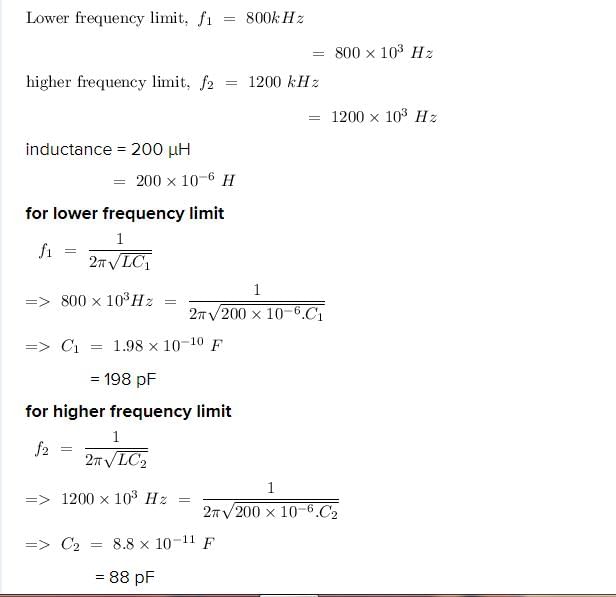
So the range is 88 - 198 pF
Comprehension TypeDirection (Q. Nos. 14-16) This section contains a paragraph, describing theory, experiments, data, etc.
Three questions related to the paragraph have been given. Each question has only one correct answer among the four given options (a), (b), (c) and (d).PassageNucleophiles which have more than one type of donor atoms within the same donor group are known as ambident nucleophile e.g.
CN- : Both carbon and nitrogen are donor.
OCN- : Both oxygen and nitrogen are donor etc.
In case of free anionic and ambident nucleophiles, the better donor atom donate its lone pair of electron and forms bond with a-carbon after substitution reaction, in a given period, donor ability decreases from left to right. In a group, donor ability increases from top to bottom.Q. When CH3CH2Br is treated with aqueous NaCN, CH3CH2CN is formed while CH3CH2NCis formed when AgCN is used in the similar reaction. It is due to- a)negative charge on carbon atom in NaCN
- b)covalent nature of Ag — C bond in AgCN
- c)covalent nature of C — N bond in NaCN
- d)ionic nature of Ag — C bond in AgCN
Correct answer is option 'B'. Can you explain this answer?
Comprehension Type
Direction (Q. Nos. 14-16) This section contains a paragraph, describing theory, experiments, data, etc.
Three questions related to the paragraph have been given. Each question has only one correct answer among the four given options (a), (b), (c) and (d).
Three questions related to the paragraph have been given. Each question has only one correct answer among the four given options (a), (b), (c) and (d).
Passage
Nucleophiles which have more than one type of donor atoms within the same donor group are known as ambident nucleophile e.g.
CN- : Both carbon and nitrogen are donor.
OCN- : Both oxygen and nitrogen are donor etc.
In case of free anionic and ambident nucleophiles, the better donor atom donate its lone pair of electron and forms bond with a-carbon after substitution reaction, in a given period, donor ability decreases from left to right. In a group, donor ability increases from top to bottom.
CN- : Both carbon and nitrogen are donor.
OCN- : Both oxygen and nitrogen are donor etc.
In case of free anionic and ambident nucleophiles, the better donor atom donate its lone pair of electron and forms bond with a-carbon after substitution reaction, in a given period, donor ability decreases from left to right. In a group, donor ability increases from top to bottom.
Q.
When CH3CH2Br is treated with aqueous NaCN, CH3CH2CN is formed while CH3CH2NCis formed when AgCN is used in the similar reaction. It is due to
a)
negative charge on carbon atom in NaCN
b)
covalent nature of Ag — C bond in AgCN
c)
covalent nature of C — N bond in NaCN
d)
ionic nature of Ag — C bond in AgCN

|
Ishita Deshpande answered |
With NaCN free cyanide (CN-) is obtained in solution, hence better donor atom carbon donate lone pair. In AgCN, due to covalent character of Ag — C bond CN- is not free in solution hence, lone pair of ‘N’ is donated
Picture shown below is example of:-
- a)Convergent evolution of Australian marsupials and placental mammals
- b)Homologous organs of both animals
- c)Divergent evolution of Australian marsupials and placental mammals
- d)Analogous organs of both animals
Correct answer is option 'A'. Can you explain this answer?
Picture shown below is example of:-
a)
Convergent evolution of Australian marsupials and placental mammals
b)
Homologous organs of both animals
c)
Divergent evolution of Australian marsupials and placental mammals
d)
Analogous organs of both animals

|
Dipanjan Chawla answered |
Wolf and Tasmania Wolf are examples of convergent evolution of placental mammals and Australian marsupials. They are evolved differently due to different in climatic and geographic regions.
Statement I: When more than one adaptive radiation appeared in isolated geographical area it called a convergent evolution.
Statement II: Bats and birds are example of adaptive radiation.
Statement III: Tiger cat, kangaroo, wombat and sugar gliders are example of Australian marsupials.- a)Statement I and II is correct
- b)Statement I and III is correct
- c)Statement II and III is correct
- d)All statements are correct
Correct answer is option 'B'. Can you explain this answer?
Statement I: When more than one adaptive radiation appeared in isolated geographical area it called a convergent evolution.
Statement II: Bats and birds are example of adaptive radiation.
Statement III: Tiger cat, kangaroo, wombat and sugar gliders are example of Australian marsupials.
Statement II: Bats and birds are example of adaptive radiation.
Statement III: Tiger cat, kangaroo, wombat and sugar gliders are example of Australian marsupials.
a)
Statement I and II is correct
b)
Statement I and III is correct
c)
Statement II and III is correct
d)
All statements are correct
|
|
Saurabh Pratap Singh answered |
Statement (1) is as it is given in Ncert , means when to adaptive radiation occurs simultaneously in an isolated geographical area it becomes convergent evolution.for eg.adaptive radiation in placental mammals divergent evolution and adaptI've radiation in marsupoals is divergent evolution , but together , it show convergent evolution
and in option (3) these all are examples of adaptive radiation in marsupials
but 2nd is wrong
and in option (3) these all are examples of adaptive radiation in marsupials
but 2nd is wrong
Which of the following is not an example of placental mammals?- a)Mole
- b)Tasmanian tiger cat
- c)Mouse
- d)Anteater
Correct answer is option 'B'. Can you explain this answer?
Which of the following is not an example of placental mammals?
a)
Mole
b)
Tasmanian tiger cat
c)
Mouse
d)
Anteater

|
Stepway Academy answered |
Tasmanian tiger cat belongs to Australian marsupials. The remaining options belong to placental mammals. The Tasmanian tiger cat resembles bobcat of placental mammals. They show convergent evolution.
Which of the following factors influence the Hardy-Weinberg equilibrium?
i. Gene migration
ii. Genetic drift
iii. Mutation
iv. Reproduction
v. Genetic recombination- a)Only iii, iv and v
- b)Only ii, iii, and iv
- c)Only i, ii, iii and v
- d)Only i, ii, iii and iv
Correct answer is option 'C'. Can you explain this answer?
Which of the following factors influence the Hardy-Weinberg equilibrium?
i. Gene migration
ii. Genetic drift
iii. Mutation
iv. Reproduction
v. Genetic recombination
i. Gene migration
ii. Genetic drift
iii. Mutation
iv. Reproduction
v. Genetic recombination
a)
Only iii, iv and v
b)
Only ii, iii, and iv
c)
Only i, ii, iii and v
d)
Only i, ii, iii and iv
|
|
Awantika Gupta answered |
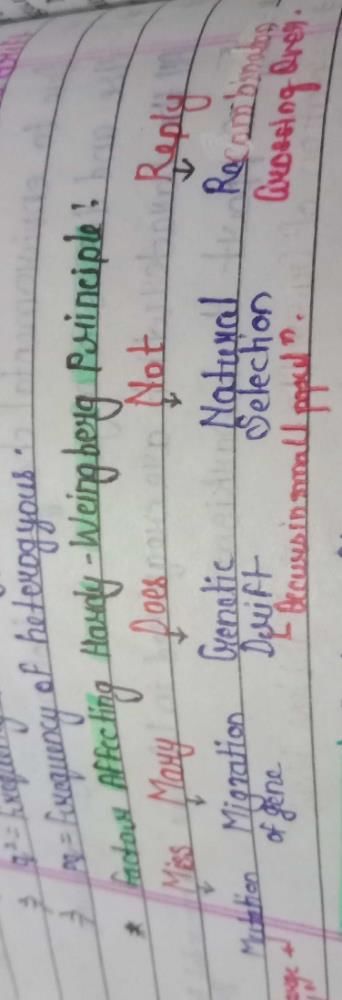
Only One Option Correct TypeDirection (Q. Nos. 1-8) This section contains 8 multiple choice questions. Each question has four choices (a), (b), (c) and (d), out of which ONLY ONE is correct.Q. Cyanide anion has two atoms th at have lone pair of electrons. Either could act as nucleophile in the reaction. Yet in the vast majority of the cases, carbon acts as nucleophile and forms a bond to the substrate, why?- a)Nitrogen is strongly solvated in hydroxylic solvents, it will be less reactive
- b)Carbon is more reactive in polar aprotic solvents, normally used for these SN2 reactions
- c)Carbon atoms are more basic than nitrogen
- d)The lone pair of electrons on C is in sp hybrid orbital
Correct answer is option 'C'. Can you explain this answer?
Only One Option Correct Type
Direction (Q. Nos. 1-8) This section contains 8 multiple choice questions. Each question has four choices (a), (b), (c) and (d), out of which ONLY ONE is correct.
Q.
Cyanide anion has two atoms th at have lone pair of electrons. Either could act as nucleophile in the reaction. Yet in the vast majority of the cases, carbon acts as nucleophile and forms a bond to the substrate, why?
a)
Nitrogen is strongly solvated in hydroxylic solvents, it will be less reactive
b)
Carbon is more reactive in polar aprotic solvents, normally used for these SN2 reactions
c)
Carbon atoms are more basic than nitrogen
d)
The lone pair of electrons on C is in sp hybrid orbital

|
Ishita Deshpande answered |
Which of the following is the example of adaptive radiation?- a)Only Australian marsupials
- b)Only Darwin finches
- c)Darwin finches and Australian marsupials
- d)Light and dark winged moths
Correct answer is option 'C'. Can you explain this answer?
Which of the following is the example of adaptive radiation?
a)
Only Australian marsupials
b)
Only Darwin finches
c)
Darwin finches and Australian marsupials
d)
Light and dark winged moths
|
|
Kushagra Budhgaya answered |
Refer ncert u'll get the explanation
Domestic power supply in India is- a)24 V D.C
- b)220 V, 50 Hz
- c)110 V, 60 Hz
- d)416 V, 60 Hz
Correct answer is option 'B'. Can you explain this answer?
Domestic power supply in India is
a)
24 V D.C
b)
220 V, 50 Hz
c)
110 V, 60 Hz
d)
416 V, 60 Hz
|
|
Rutuja Ahuja answered |
Domestic Power Supply in India
India's domestic power supply is typically provided at a voltage of 220 V with a frequency of 50 Hz. This standard is followed across the country for residential buildings and households.
Reasoning
- The voltage of 220 V is considered to be the most suitable for powering household appliances and lighting systems efficiently without causing damage.
- The frequency of 50 Hz is the standard in India and many other countries, ensuring compatibility with most electrical devices used in households.
Comparison with other options
- 24 V D.C: This voltage level is too low for powering most household appliances and lighting systems effectively.
- 110 V, 60 Hz: This combination is commonly used in countries like the United States, but in India, the standard is 220 V, 50 Hz.
- 416 V, 60 Hz: This voltage level is too high for domestic use and is typically used for industrial applications.
In conclusion, the standard domestic power supply in India is 220 V, 50 Hz, which is well-suited for powering household appliances and lighting systems efficiently and safely.
India's domestic power supply is typically provided at a voltage of 220 V with a frequency of 50 Hz. This standard is followed across the country for residential buildings and households.
Reasoning
- The voltage of 220 V is considered to be the most suitable for powering household appliances and lighting systems efficiently without causing damage.
- The frequency of 50 Hz is the standard in India and many other countries, ensuring compatibility with most electrical devices used in households.
Comparison with other options
- 24 V D.C: This voltage level is too low for powering most household appliances and lighting systems effectively.
- 110 V, 60 Hz: This combination is commonly used in countries like the United States, but in India, the standard is 220 V, 50 Hz.
- 416 V, 60 Hz: This voltage level is too high for domestic use and is typically used for industrial applications.
In conclusion, the standard domestic power supply in India is 220 V, 50 Hz, which is well-suited for powering household appliances and lighting systems efficiently and safely.
Which of the following would react most rapidly with sodium ethoxide to produce an ether?- a)Chlorobenzene
- b)2-nitrotoluene
- c)p-nitrochlorobenzene
- d)m-(chloromethyl)-toluene
Correct answer is option 'D'. Can you explain this answer?
Which of the following would react most rapidly with sodium ethoxide to produce an ether?
a)
Chlorobenzene
b)
2-nitrotoluene
c)
p-nitrochlorobenzene
d)
m-(chloromethyl)-toluene

|
Gauri Kaur answered |
In all other cases leaving group is on phenyl ring, not substituted, usually by nucleophiles under ordinary condition.
Adaptive radiation does not confirm _______- a)Convergent evolution
- b)Homology
- c)Divergent evolution
- d)Evolution of new forms
Correct answer is option 'A'. Can you explain this answer?
Adaptive radiation does not confirm _______
a)
Convergent evolution
b)
Homology
c)
Divergent evolution
d)
Evolution of new forms

|
EduRev NEET answered |
- It is not adaptive radiation that confirms convergent evolution.
- It is an adaptive convergence that confirms convergent evolution.
- The remaining options are applicable to adaptive radiation.
The main reason for preferring usage of AC voltage over DC voltage- a)AC voltages can be easily and efficiently converted from one voltage to the other by means of transformers
- b)DC uses alternators whereas AC uses generators
- c)DC Batteries are of low voltage
- d)There are no DC generators
Correct answer is option 'A'. Can you explain this answer?
The main reason for preferring usage of AC voltage over DC voltage
a)
AC voltages can be easily and efficiently converted from one voltage to the other by means of transformers
b)
DC uses alternators whereas AC uses generators
c)
DC Batteries are of low voltage
d)
There are no DC generators

|
Anoushka Chopra answered |
Explanation:By using the phenomenon of mutual induction, transformers allow us to easily change voltage of AC. This is necessary to cut down poer losses while supplying electricity to our homes
You have a 200.0 ΩΩ resistor, a 0.400-H inductor, a 5.0 μF capacitor, and a variable frequency ac source with an amplitude of 3.00 V. You connect all four elements together to form a series circuit. Frequency at which current in the circuit is greatest and its amplitude are- a)143 Hz, 35mA
- b)123 Hz, 15mA
- c)113 Hz, 15mA
- d)113 Hz, 25mA
Correct answer is option 'C'. Can you explain this answer?
You have a 200.0 ΩΩ resistor, a 0.400-H inductor, a 5.0 μF capacitor, and a variable frequency ac source with an amplitude of 3.00 V. You connect all four elements together to form a series circuit. Frequency at which current in the circuit is greatest and its amplitude are
a)
143 Hz, 35mA
b)
123 Hz, 15mA
c)
113 Hz, 15mA
d)
113 Hz, 25mA
|
|
Nabanita Pillai answered |
The resistance is R=200ohm the inductor is L=0.4 H, the capacitance is C=5 µF and the amplitude voltage is V=CV
The frequency depends on the inductance and the capacitance and it is given by,
f0=1/ (2π√(LC))
So, plug the values of L and C into equation 1 to get f0
f0=1/ (2π√(LC))=2/(2π√[0.4H)(5x10-6)]=113Hz
for the current, we use ohm’s law to get the current,
I=V/R
Now, plug the values for V and R to get I
I=V/R=3V/200Ω=0.015A=15mA
The frequency depends on the inductance and the capacitance and it is given by,
f0=1/ (2π√(LC))
So, plug the values of L and C into equation 1 to get f0
f0=1/ (2π√(LC))=2/(2π√[0.4H)(5x10-6)]=113Hz
for the current, we use ohm’s law to get the current,
I=V/R
Now, plug the values for V and R to get I
I=V/R=3V/200Ω=0.015A=15mA
Transformer uses the principle of- a)charge conservation
- b)conduction
- c)Induction
- d)least action
Correct answer is option 'C'. Can you explain this answer?
Transformer uses the principle of
a)
charge conservation
b)
conduction
c)
Induction
d)
least action
|
|
Harsh Singhal answered |
In this process from one plate to other plate magnetic flux generated
An LC circuit contains a 20 mH inductor and a 50 μF capacitor with an initial charge of 10 mC. The resistance of the circuit is negligible. Natural frequency of the circuit is- a)129 Hz
- b)149 Hz
- c)159 Hz
- d)139 Hz
Correct answer is option 'C'. Can you explain this answer?
An LC circuit contains a 20 mH inductor and a 50 μF capacitor with an initial charge of 10 mC. The resistance of the circuit is negligible. Natural frequency of the circuit is
a)
129 Hz
b)
149 Hz
c)
159 Hz
d)
139 Hz
|
|
Anagha Mukherjee answered |
Natural frequency of the circuit, f = 1/2π√(LC)
here, L = 20mH = 20 × 10-3 H, C = 50μF = 50 × 10-6 C
so, f = 1/2π√(20 × 10-3 × 50 × 10-6)
= 1/2π√(1000 × 10-9)
= 1/2π√(10-6)
= 1000/2π = 500/π Hz ≈ 159 Hz
here, L = 20mH = 20 × 10-3 H, C = 50μF = 50 × 10-6 C
so, f = 1/2π√(20 × 10-3 × 50 × 10-6)
= 1/2π√(1000 × 10-9)
= 1/2π√(10-6)
= 1000/2π = 500/π Hz ≈ 159 Hz
One Integer Value Correct TypeDirection (Q. Nos. 17 and 18) This section contains 2 questions. When worked out will result in an integer from 0 to 9 (both inclusive).Q. If meso form of the 2,4-dibromopentane is treated with excess of KCN(aq), how many SN2 products with both bromide substituted, wouid result?
Correct answer is '4'. Can you explain this answer?
One Integer Value Correct Type
Direction (Q. Nos. 17 and 18) This section contains 2 questions. When worked out will result in an integer from 0 to 9 (both inclusive).
Q.
If meso form of the 2,4-dibromopentane is treated with excess of KCN(aq), how many SN2 products with both bromide substituted, wouid result?

|
Nidhi Yadav answered |
Nucleophiles which have more than one type of donor atoms within the same donor group are known as ambident nucleophile e.g.
CN- : Both carbon and nitrogen are donor.
OCN- : Both oxygen and nitrogen are donor etc.
In case of free anionic and ambident nucleophiles, the better donor atom donate its lone pair of electron and forms bond with a-carbon after substitution reaction, in a given period, donor ability decreases from left to right. In a group, donor ability increases from top to bottom.Q. When iodomethane is treated with sodium isocyanate (NaNCO), CH3NCO is the major product while AgNCO gives CH3CH2OCN as major product because- a)negative charge on nitrogen in NaNCO and on oxygen in AgNCO
- b)negative charge on oxygen atom in both salts
- c)free NCO- in case of NaNCO and covalent Ag —N bond in AgNCO
- d)greater basicity of nitrogen In NaNCO and oxygen in AgNCO
Correct answer is option 'C'. Can you explain this answer?
Nucleophiles which have more than one type of donor atoms within the same donor group are known as ambident nucleophile e.g.
CN- : Both carbon and nitrogen are donor.
OCN- : Both oxygen and nitrogen are donor etc.
In case of free anionic and ambident nucleophiles, the better donor atom donate its lone pair of electron and forms bond with a-carbon after substitution reaction, in a given period, donor ability decreases from left to right. In a group, donor ability increases from top to bottom.
CN- : Both carbon and nitrogen are donor.
OCN- : Both oxygen and nitrogen are donor etc.
In case of free anionic and ambident nucleophiles, the better donor atom donate its lone pair of electron and forms bond with a-carbon after substitution reaction, in a given period, donor ability decreases from left to right. In a group, donor ability increases from top to bottom.
Q.
When iodomethane is treated with sodium isocyanate (NaNCO), CH3NCO is the major product while AgNCO gives CH3CH2OCN as major product because
a)
negative charge on nitrogen in NaNCO and on oxygen in AgNCO
b)
negative charge on oxygen atom in both salts
c)
free NCO- in case of NaNCO and covalent Ag —N bond in AgNCO
d)
greater basicity of nitrogen In NaNCO and oxygen in AgNCO
|
|
Prateek Jain answered |
Explanation:
Reason for the major product formation:
- When iodomethane reacts with sodium isocyanate (NaNCO) or silver isocyanate (AgNCO), the major product formed is CH3NCO and CH3CH2OCN respectively.
- This difference in product formation is due to the nature of the isocyanate ion (NCO-).
Explanation of option 'C':
- The major reason for the different products formed is the difference in the nature of the NCO- ion in NaNCO and AgNCO.
- In the case of NaNCO, the NCO- ion is free and has a negative charge on the nitrogen atom, making it a free anionic nucleophile.
- In the case of AgNCO, the NCO- ion forms a covalent bond with silver, which changes the nature of the nucleophile to an ambident nucleophile.
- The free NCO- ion in NaNCO has a greater tendency to donate its lone pair of electrons to the electrophile, resulting in the formation of CH3NCO as the major product.
- On the other hand, the NCO- ion in AgNCO has a covalent N bond with silver, which affects its donor ability and results in the formation of CH3CH2OCN as the major product.
Therefore, the correct explanation for the major product formation in the reaction of iodomethane with NaNCO and AgNCO lies in the difference in the nature of the NCO- ion in the two salts.
An electric hair dryer is rated at 1500 W (the average power) at 120 V (the rms voltage). Calculate (a) the resistance, (b) the rms current, and (c) the maximum instantaneous power. Assume that the dryer is a pure resistor.- a)10.6 Ω , 13.5 A, 3000 W
- b)7.6 Ω , 14.5 A, 3000 W
- c)8.6 Ω, 11.5 A, 3000 W
- d)9.6 Ω, 12.5 A, 3000 W
Correct answer is option 'D'. Can you explain this answer?
An electric hair dryer is rated at 1500 W (the average power) at 120 V (the rms voltage). Calculate (a) the resistance, (b) the rms current, and (c) the maximum instantaneous power. Assume that the dryer is a pure resistor.
a)
10.6 Ω , 13.5 A, 3000 W
b)
7.6 Ω , 14.5 A, 3000 W
c)
8.6 Ω, 11.5 A, 3000 W
d)
9.6 Ω, 12.5 A, 3000 W
|
|
Amar Das answered |
Given,
Pavg=1200W
Vrms=120 Volts
A,
The resistance is,
R=Vrms2/Pavg
So,R=1202/1500=9.6ohm
B,
The rms current is,
Irms=Vrms/R
So, Irms=120/9.6
=>Irms=12.5A
C,
The maximum instantaneous power is,
Pm=2Pavg
So,Pm=2(1500)
=>Pm=3000W.
Hence option D is the correct answer.
Pavg=1200W
Vrms=120 Volts
A,
The resistance is,
R=Vrms2/Pavg
So,R=1202/1500=9.6ohm
B,
The rms current is,
Irms=Vrms/R
So, Irms=120/9.6
=>Irms=12.5A
C,
The maximum instantaneous power is,
Pm=2Pavg
So,Pm=2(1500)
=>Pm=3000W.
Hence option D is the correct answer.
A 100 μF capacitor in series with a 40 Ω resistance is connected to a 110 V, 60 Hz supply. Maximum current in the circuit and time lag between the current maximum and the voltage maximum are- a)2.93 A, 1.55 ms
- b)2.53 A, 1.55 ms
- c)3.03 A, 1.50 ms
- d)3.23 A, 1.55 ms
Correct answer is option 'D'. Can you explain this answer?
A 100 μF capacitor in series with a 40 Ω resistance is connected to a 110 V, 60 Hz supply. Maximum current in the circuit and time lag between the current maximum and the voltage maximum are
a)
2.93 A, 1.55 ms
b)
2.53 A, 1.55 ms
c)
3.03 A, 1.50 ms
d)
3.23 A, 1.55 ms

|
Sankar Gupta answered |
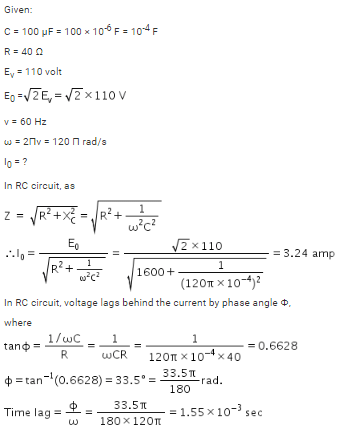
Which of the following gives the different substitution product with CH3CH2Br when their sodium and silver salts are used?- a)CN-
- b)OCN-
- c)SCN-
- d)

Correct answer is option 'A,C'. Can you explain this answer?
Which of the following gives the different substitution product with CH3CH2Br when their sodium and silver salts are used?
a)
CN-
b)
OCN-
c)
SCN-
d)

|
Bhavana Banerjee answered |
Silver salts have covalent character, hence lone pair of free atom i.e. nitrogen in both cases donate lone pair. With sodium salts, nucleophiles are free ions in solution, better donor donate lone pair.
Average power supplied to a capacitor over one complete cycle- a)is always positive
- b)is 1
- c)is always negative
- d)is zero
Correct answer is option 'D'. Can you explain this answer?
Average power supplied to a capacitor over one complete cycle
a)
is always positive
b)
is 1
c)
is always negative
d)
is zero

|
Janhavi Kaur answered |
Explanation:We know that in capacitor Current leads Voltage by 90degree. Over one complete cycle, in first quarter cycle Capacitor charges and next quarter cycle it's discharge. This will continue in next negative half cycle. So the NET POWER ABSORB IS ZERO.
Alternating current is so called because- a)Voltage alternates between 0 V and 5 V
- b)Polarity alternates from + to – and – to + with time
- c)Current is switched on and off alternately
- d)Voltage alternates between 10 V and 15 V
Correct answer is option 'B'. Can you explain this answer?
Alternating current is so called because
a)
Voltage alternates between 0 V and 5 V
b)
Polarity alternates from + to – and – to + with time
c)
Current is switched on and off alternately
d)
Voltage alternates between 10 V and 15 V

|
Keerthana Mehta answered |
Explanation:Alternating Current is the current in which the polarity of source continuously changes on a fixed frequency. So the positive and the negative terminals ‘alternate’
Consider the following substitution reaction, Q. The correct statement(s) is/are
Q. The correct statement(s) is/are- a)reaction occur at much faster rate than when substrate is 2-bromo-3,3-dimethyl pentane
- b)reaction occur with inversion of configuration
- c)reaction occur with retention of configuration
- d)E2 product is preferred over SN2
Correct answer is option 'A,C'. Can you explain this answer?
Consider the following substitution reaction,
Q.
The correct statement(s) is/are
a)
reaction occur at much faster rate than when substrate is 2-bromo-3,3-dimethyl pentane
b)
reaction occur with inversion of configuration
c)
reaction occur with retention of configuration
d)
E2 product is preferred over SN2

|
Baishali Chakraborty answered |
Due to neighbouring group participation, reaction occurs at much faster rate than 2-bromo-3, 3-dimethylpentane. Also it involves SN2 reaction twice, overall retention of configuration is observed.
Nucleophiles which have more than one type of donor atoms within the same donor group are known as ambident nucleophile e.g.
CN- : Both carbon and nitrogen are donor.
OCN- : Both oxygen and nitrogen are donor etc.
In case of free anionic and ambident nucleophiles, the better donor atom donate its lone pair of electron and forms bond with a-carbon after substitution reaction, in a given period, donor ability decreases from left to right. In a group, donor ability increases from top to bottom.Q. Treatment of CH3CH2Br with either NaNO2 or AgNO2 gives the same nitroethane as major product because- a)negative charge on nitrogen atom in both salts
- b)nitrogen lone pair is free in both salts, more easily donated than oxygen lone pair
- c)NaNO2 gives free
 in solution
in solution - d)AgNO2 has Ag covalently bonded to oxygen
Correct answer is option 'B'. Can you explain this answer?
Nucleophiles which have more than one type of donor atoms within the same donor group are known as ambident nucleophile e.g.
CN- : Both carbon and nitrogen are donor.
OCN- : Both oxygen and nitrogen are donor etc.
In case of free anionic and ambident nucleophiles, the better donor atom donate its lone pair of electron and forms bond with a-carbon after substitution reaction, in a given period, donor ability decreases from left to right. In a group, donor ability increases from top to bottom.
CN- : Both carbon and nitrogen are donor.
OCN- : Both oxygen and nitrogen are donor etc.
In case of free anionic and ambident nucleophiles, the better donor atom donate its lone pair of electron and forms bond with a-carbon after substitution reaction, in a given period, donor ability decreases from left to right. In a group, donor ability increases from top to bottom.
Q.
Treatment of CH3CH2Br with either NaNO2 or AgNO2 gives the same nitroethane as major product because
a)
negative charge on nitrogen atom in both salts
b)
nitrogen lone pair is free in both salts, more easily donated than oxygen lone pair
c)
NaNO2 gives free  in solution
in solution
d)
AgNO2 has Ag covalently bonded to oxygen

|
Gauri Kaur answered |
In both salts, lone pair on nitrogen (better donor atom than oxygen) is free for donation to alkyl halide.
One or More than One Options Correct TypeDirection (Q. Nos. 9-13) This section contains 5 multiple choice questions. Each question has four choices (a), (b), (c) and (d), out of which ONE or MORE THAN ONE are correct.Q. Pick out the alkyl bromides which proceeds with retention of configuration in an SN2 reaction with CH3ONa(aq)- a)

- b)

- c)

- d)

Correct answer is option 'A,B,C'. Can you explain this answer?
One or More than One Options Correct Type
Direction (Q. Nos. 9-13) This section contains 5 multiple choice questions. Each question has four choices (a), (b), (c) and (d), out of which ONE or MORE THAN ONE are correct.
Q.
Pick out the alkyl bromides which proceeds with retention of configuration in an SN2 reaction with CH3ONa(aq)
a)
b)
c)
d)

|
Gauri Kaur answered |
All will react via cyclic sulphonium ion intermediate involving SN2 reaction twice giving over all retention of configuration.
Consider the following reaction,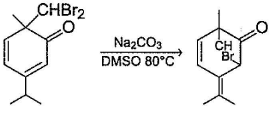 Q. What can be correctly predicted regarding this reaction?
Q. What can be correctly predicted regarding this reaction?- a)SN1 reaction is occurring
- b)SN2 reaction is occurring
- c)Neighbouring group participation and SN2 reaction are occurring
- d)Neighbouring group participation and SN1 reaction are occurring
Correct answer is option 'C'. Can you explain this answer?
Consider the following reaction,
Q.
What can be correctly predicted regarding this reaction?
a)
SN1 reaction is occurring
b)
SN2 reaction is occurring
c)
Neighbouring group participation and SN2 reaction are occurring
d)
Neighbouring group participation and SN1 reaction are occurring

|
Nidhi Yadav answered |
Matching List TypeDirection (Q. No. 19) Choices for the correct combination of elements from Column I and Column II are given as options (a), (b), (c) and (d), out of which one is correct.Q. Match the Column I with Column II and mark the correct option from the codes given below.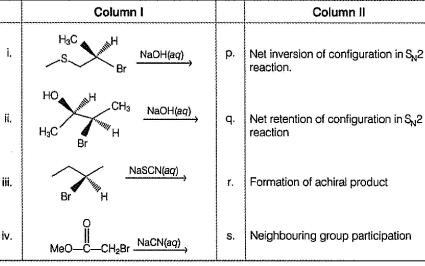
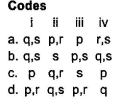
- a)a
- b)b
- c)c
- d)d
Correct answer is option 'A'. Can you explain this answer?
Matching List Type
Direction (Q. No. 19) Choices for the correct combination of elements from Column I and Column II are given as options (a), (b), (c) and (d), out of which one is correct.
Q.
Match the Column I with Column II and mark the correct option from the codes given below.
a)
a
b)
b
c)
c
d)
d

|
Baishali Chakraborty answered |
(i) Due to ‘S' at β-position, neighbouring group participation occur giving net retention (twice inversion).
(ii) SN2 at α-carbon gives inversion and product is meso diol,
(iii) Only SN2 hence inversion
(iv) Show neighbouring group effect
(ii) SN2 at α-carbon gives inversion and product is meso diol,
(iii) Only SN2 hence inversion
(iv) Show neighbouring group effect
Chapter doubts & questions for October Week 3 - Weekly Tests for NEET Preparation 2025 is part of NEET exam preparation. The chapters have been prepared according to the NEET exam syllabus. The Chapter doubts & questions, notes, tests & MCQs are made for NEET 2025 Exam. Find important definitions, questions, notes, meanings, examples, exercises, MCQs and online tests here.
Chapter doubts & questions of October Week 3 - Weekly Tests for NEET Preparation in English & Hindi are available as part of NEET exam.
Download more important topics, notes, lectures and mock test series for NEET Exam by signing up for free.
Related NEET Content

Contact Support
Our team is online on weekdays between 10 AM - 7 PM
Typical reply within 3 hours
|
Free Exam Preparation
at your Fingertips!
Access Free Study Material - Test Series, Structured Courses, Free Videos & Study Notes and Prepare for Your Exam With Ease

 Join the 10M+ students on EduRev
Join the 10M+ students on EduRev
|

|
Create your account for free
OR
Forgot Password
OR
Signup to see your scores
go up
within 7 days!
within 7 days!
Takes less than 10 seconds to signup


